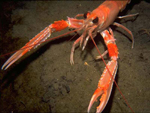CrustaceansCrustaceans are invertebrates that belong to the Arthropod group. Within the subphylum Crustacea, the decapod's order has special relevance since it comprises a great number of species and presents a large variety of forms, encompassing the Natantia (shrimps) and the Reptantia (crayfish, lobsters, crabs). Furthermore, this order is the most important for the commercial exploitation of crustaceans worldwide.In all decapods, the first three pairs of thoracic appendages are modified and function as mouthparts (maxillipeds) and the remaining five, hence the name Decapoda, are used in locomotion (paraeopods). In the swimming decapods (Natantia), there are abdominal appendages with long setae (pleopods) that operate as swimming organs. The sexes are separated in most crustaceans (although there are some cases of hermaphroditism), being the gametes expelled by the copulatory organs of the males and the oviducts of females. Fecundation is almost always external. Crustaceans need periodically to moult their exoskeleton in order to grow. The moult is also termed exuviation or ecdysis and is one of the most complex and fascinating physiological processes of this subphylum. |
||||
 |
 |
 |
||